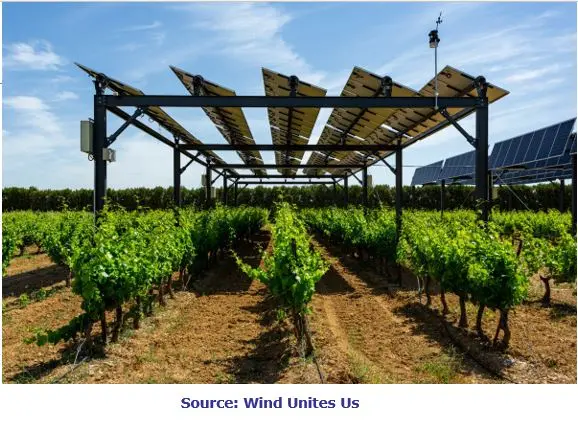

Agrivoltaics, a term that encapsulates the integration of agriculture with solar photovoltaic (PV) systems, is gaining traction as a solution-oriented approach. This method offers a dual advantage by addressing the pressing needs of food production and sustainable energy generation. By combining these two sectors, agrivoltaics presents a unique opportunity to harness the sun's energy while cultivating crops.
Let’s examine the current status, evolution, challenges, and future prospects of agrivoltaics.
The concept of agrivoltaics, which took root in France in 2011, has since expanded its footprint, especially in the United States, which now boasts over 300 installations. These systems offer a myriad of tangible benefits, from efficient water utilization and enhanced soil productivity to fostering biodiversity. The approach is not just about co-locating crops and solar panels; it's about creating a symbiotic relationship between the two. Recognizing the potential of this integration, earlier this year, U.S. Senator Martin Heinrich, Chairman of the Senate Appropriations Subcommittee on Agriculture, Rural Development, Food and Drug Administration, and U.S. Senator Mike Braun, a member of the Senate Agriculture Committee and the Ranking Member of the Subcommittee on Food and Nutrition, Specialty Crops, Organics, and Research introduced the Agrivoltaics Research and Demonstration Act of 2023. This legislative support underscores the importance of agrivoltaics in promoting sustainable land use and advancing renewable energy.

While agrivoltaic applications are promising, they are not without challenges. The initial capital required for setting up these systems can be substantial, making it a significant financial barrier [GS1]. Additionally, concerns related to worker safety during installation and maintenance, potential liability issues, and navigating the complex landscape of business, legal, and regulatory compliance are other hurdles. In regions characterized by arid conditions, deploying agrivoltaic systems demands custom solutions to ensure both crop and energy yields. Addressing these challenges requires a combination of technological innovation, policy support, and industry collaboration.
Harnessing the full potential of agrivoltaics requires continuous innovation in technology and practices. New methodologies are being developed to enhance the efficiency and benefits of integrating agriculture with PV systems. The U.S. Department of Energy is playing a pivotal role in this arena, leading research initiatives to understand the economic, environmental, and societal implications of agrivoltaics. This research endeavors to uncover potential tradeoffs, understand ecological impacts, and develop technologies that can streamline the adoption of agrivoltaics. With a focus on sustainability, these innovations are crucial for the long-term viability and success of agrivoltaic systems.
For the farming community, agrivoltaics represents more than just an innovative approach; it can be a pathway to resilience. By integrating solar panels with crops, farmers can diversify their income sources, tapping into the lucrative energy sector while continuing their agricultural practices. This approach also offers farmers a means to adapt to changing climatic conditions, as the shade from solar panels can create microclimates that benefit certain crops. Preliminary studies and on-ground implementations have shown that agrivoltaics can lead to improved crop yields, especially in regions prone to extreme weather events. Thus, agrivoltaics not only addresses food security but also contributes to the broader goal of agricultural sustainability.
Agrivoltaic systems, when designed and implemented thoughtfully, can serve dual purposes. They can enhance agricultural output while also supporting biodiversity, especially when native plants are integrated. This approach can play an important role in enhancing ecosystem services, from soil enrichment to water conservation and supporting pollinators. Moreover, by reducing land-use conflicts between energy production and conservation efforts, agrivoltaics offers a balanced approach. It showcases how energy production and biodiversity conservation can coexist without compromising the integrity of either.
Agrivoltaics is not just a current trend; it is poised to play a significant role in the global sustainability landscape. Its alignment with several United Nations Sustainable Development Goals (SDGs) underscores its importance in the broader context of global sustainability efforts. By offering a comprehensive solution to the interwoven challenges of food production, energy generation, and environmental conservation, agrivoltaics is setting new benchmarks. As technology evolves and more research insights emerge, agrivoltaics will likely grow its position as a key player in promoting biodiversity conservation, ecosystem service enhancement, and the harmonious coexistence of agricultural and energy sectors.
In essence, agrivoltaics represents a pragmatic and efficient integration of agriculture with solar energy production. It offers a tangible solution to some of society’s most pressing challenges. Through focused research, technological advancements, and industry collaboration, agrivoltaics is moving towards a future where food production and sustainable energy generation can seamlessly coexist. This approach not only benefits the environment but also offers economic advantages, making it a win-win for all stakeholders involved.
[GS1] Maybe add an average cost from the 300 in the USA?

